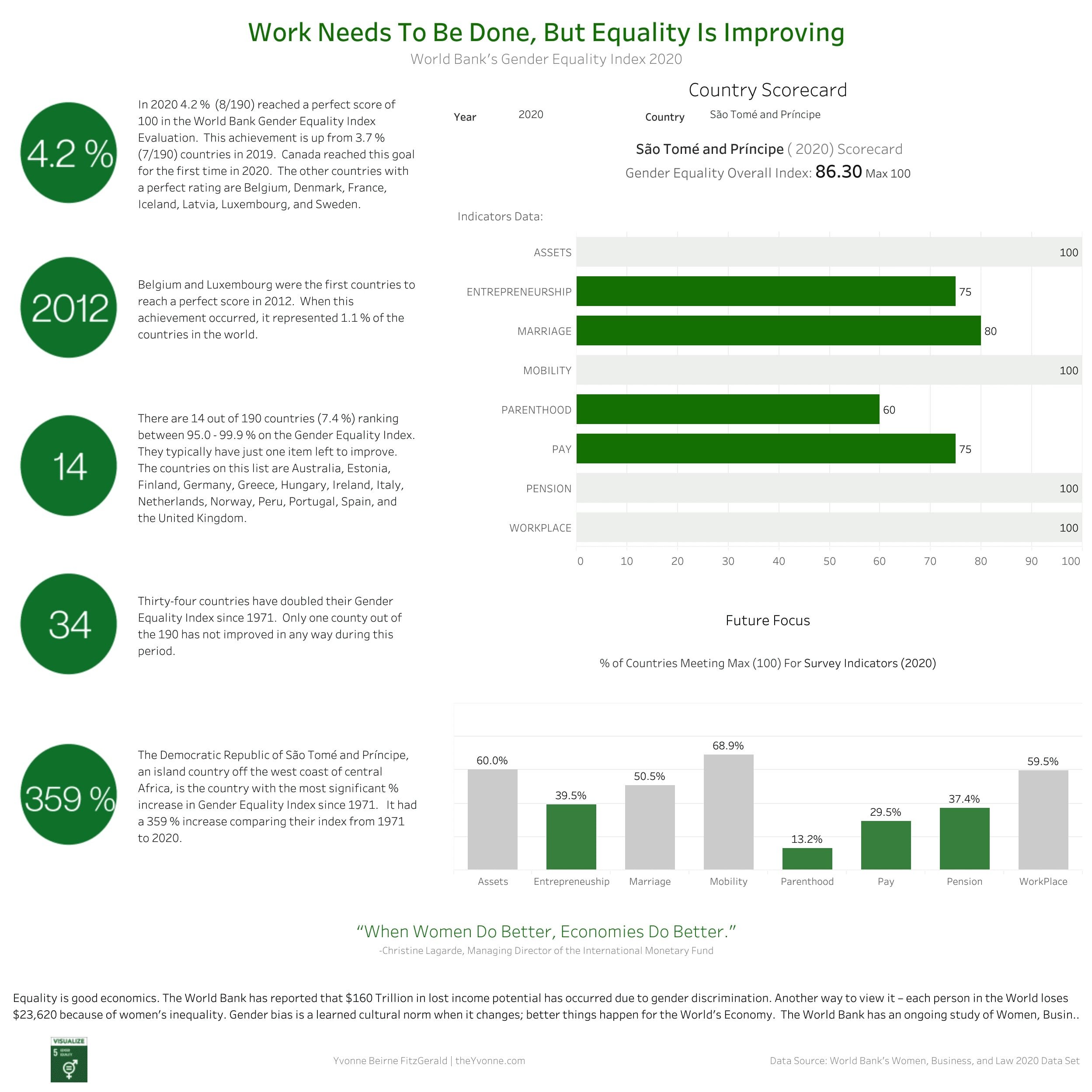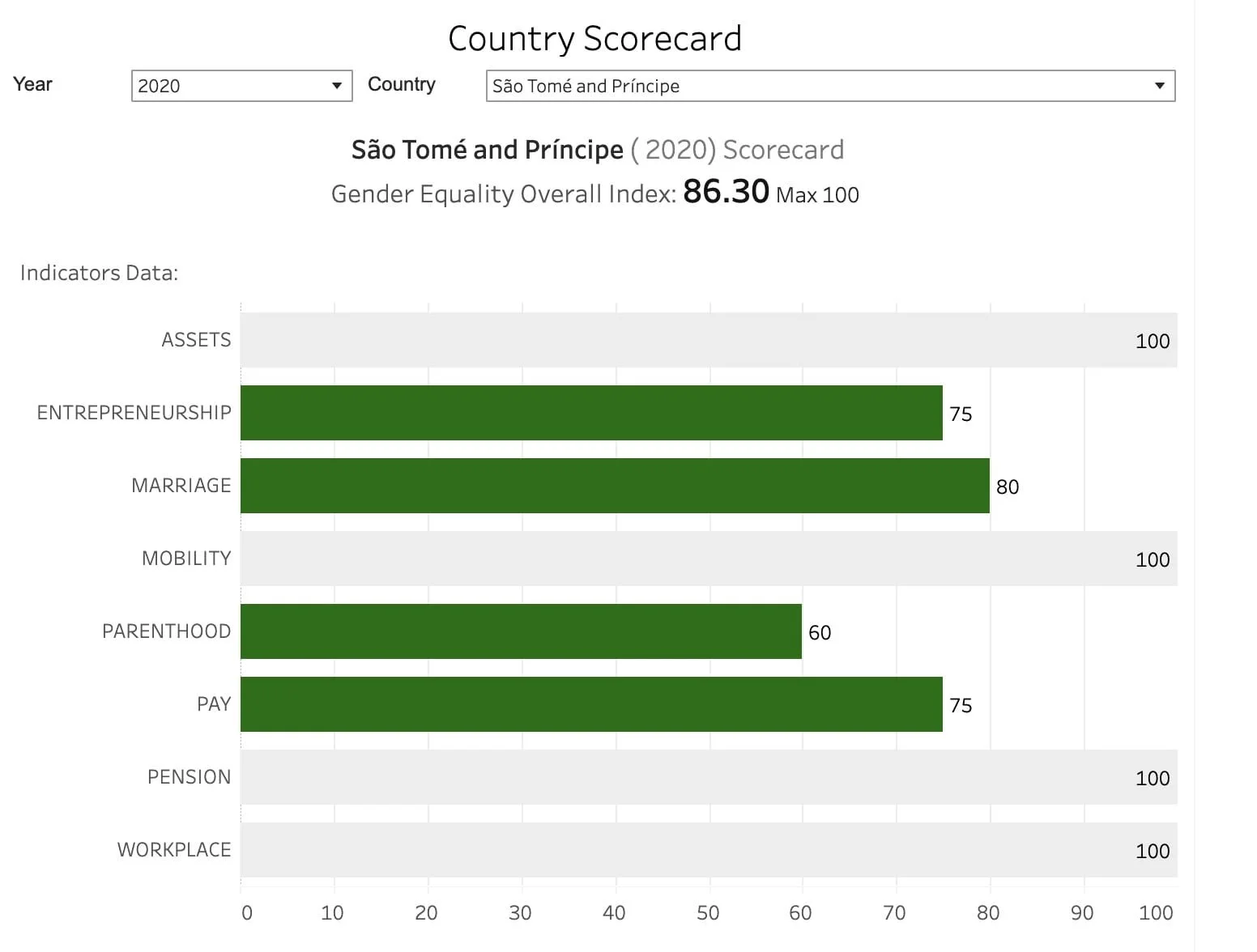Gender Equality Index
Based on the World Bank's Women, Business, and Law 2020 Data Set
“When women do better, economies do better.”
— Christine Lagarde, Managing Director of the International Monetary Fund
Project Goals
1. A Data Vis Illustrating the World Bank’s Gender Equality Index
2. Demonstrate how Gender Equality has improved over time
3. Create a tool that allows the viewer to explore the data
Project Features
Design
The use of the highlights allows the visitor to visualize and get a broad understanding of the present status of gender equality, how it has changed over time and exploring the data based on the viewer’s interest. There was a significant amount of information to reduce into a single sheet visualization.
Project Design
This data set contains many different and vital stories. I decided to focus on two critical ones that are connected. First, though there is much work required to eliminate gender inequality, equality is improving globally. The second is providing a snapshot of what is the current state of Gender Equality in the world.
Storytelling
Storytelling with data is a powerful way to change minds and acknowledge how far we have come and what still is needed. In this project, I selected to highlight the improvements in Gender Equality since 1971 based on the World Bank’s data. I also created a tool to allow the visitor to understand where and what work needs is needed.
Design Decisions
Interactive Filters
I used interactive filters in this design to allow both user persona to approach the data from their area of interest.
Use of Color
Avoiding the use of pink in the viz was one of the earliest design decisions. I explored several color palettes to find one that worked. Eventually I selected a color that conveyed both positive energy and hope. These feelings match the trend of the data.
Issues and Challenges
The major challenge was making an intuitive and easy to use visualization. The project needs two deliverables:
an exploratory country scorecard to dive into how a country has changed over time
a story highlights to explain how equality is changing over time
A secondary challenge is due to the amount of data that is available – what to feature and to exclude. This issue is a great one to have. I approached the visualization story as one of hope – even though there is still more work to be done, things are changing and improving.
Key Takeaways
This data set lends itself to several numerous different stories. Highlighting the five key achievements was critical in telling the overall story. Without creating the highlighted points, the improvements in gender equality disappear in a mountain of numbers.
I always knew the power of color selection. In this project, looking at how the user’s impressions are influenced by changing different palettes was an exciting exploration, and confirming this knowledge.
Overview
Equality is good economics. The World Bank has reported that $160 Trillion in lost income potential has occurred due to gender discrimination. Another way to view it – each person in the World loses $23,620 because of women’s inequality. Gender bias is a learned cultural norm when it changes, better things happen for the World’s Economy.
The World Bank has an ongoing study of Women, Business, and Law (WBL) and releases a report annually. The data used in this visualization is from Women, Business, and the Law (WBL) 2020 data set. It contains information for 190 countries from 1970 to 2019 (reporting years 1971 to 2020). Thirty-five questions covering eight indicators comprise the Gender Equality Index. The eight indicators are Assets, Entrepreneurship, Marriage, Mobility, Parenthood, Pay, Pension, and Workplace.
Details
Women, Banking, and Law 2020 is a World Bank report released on 27 February 2020. The World Bank also shares the study data. The data is current up to September 2019. After reading the study; I still had unanswered questions. I wanted a tool to allow for a dive deeper into the data.
The data is in an excel spreadsheet without any visualizations. This format makes it challenging to explore and understand the data. I thought others would want or need to dive deeper into the data, so the project was born. There is a significant amount of detailed and historical data collected in the World Bank’s study. In reviewing the report, it is hard to see the changes in Gender Equality over time. When displaying the data with a vis, then improvements are shown. It is also challenging to get into the study’s details in a spreadsheet form. Examining the data at the detail level gives the viewers an understanding of what needs to change and works for each economy. Providing this information in an easy to use data visualization that enables conversations is a key deliverable.
The fundamental goal of this project is to allow the end-users to deep dive into the data. For this reason, interactive visualization is the primary driver. It will enable end-users to look at the specific country level data. A second goal is to create a visualization illustrating the changing transition toward Gender Equality over time.
Appendix A: Study Details
The World Bank has an ongoing study of Women, Business, and Law (WBL) and releases a report annually. It contains information for 190 countries from 1970 to 2019 (reporting years 1971 to 2020). Thirty-five questions covering eight indicators comprise the Gender Equality Index. The eight indicators are Assets, Entrepreneurship, Marriage, Mobility, Parenthood, Pay, Pension, and Workplace. Each question is weighted equally within its section.
Mobility
Can a woman choose where to live in the same way as a man?
Can a woman apply for a passport in the same way as a man?
Can a woman travel outside the country in the same way as a man?
Can a woman travel outside her home in the same way as a man?
Entrepreneurship
Can a woman sign a contract in the same way as a man?
Can a woman register a business in the same way as a man?
Can a woman open a bank account in the same way as a man?
Does the law prohibit discrimination in access to credit based on gender?
Parenthood
Is paid leave of at least 14 weeks available to mothers?
Does the government administer 100% of maternity leave benefits?
Is paid leave available to fathers?
Is there paid parental leave?
Is dismissal of pregnant workers prohibited?
Pay
Does the law mandate equal remuneration for work of equal value?
Can women work the same night hours as men?
Can women work in jobs deemed dangerous in the same way as men?
Are women able to work in the same industries as men?
Pension
Are the ages at which men and women can retire with partial pension benefits equal?
Is the mandatory retirement age for men and women equal?
Are periods of absence from work due to childcare accounted for in pension benefits?
Workplace
Can a woman get a job in the same way as a man?
Does the law prohibit discrimination in employment based on gender?
Is there legislation on sexual harassment in employment?
Are there criminal penalties or civil remedies for sexual harassment in employment?
Marriage
Is there no legal provision that requires a married woman to obey her husband?
Can a woman be “head of household” or “head of family” in the same way as a man?
Is there legislation specifically addressing domestic violence?
Can a woman obtain a judgment of divorce in the same way as a man?
Does a woman have the same rights to remarry as a man?
Assets
Do men and women have equal ownership rights to immovable property?
Do sons and daughters have equal rights to inherit assets from their parents?
Do female and male surviving spouses have equal rights to inherit assets?
Does the law grant spouses equal administrative authority over assets during marriage?
Does the law provide for the valuation of non monetary contributions?
Summary Info
Project: Gender Equality Index From World Bank’s Women and Business, and the Law Data Set 2020
Tableau Gallery: Tableau Public Gallery: Yvonne
Viz: Tableau
Skills: Tableau, Dashboard Creation, Project Design, Storytelling
Data Source: Women, Business and the Law Data














